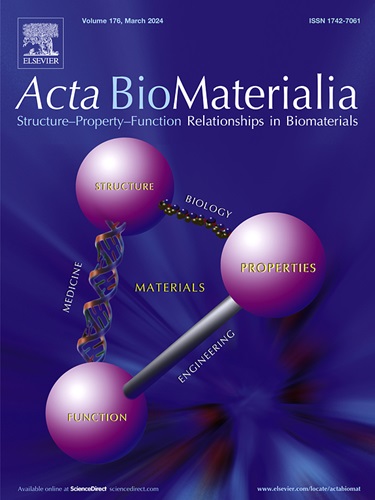Mechanical properties, degradation action, and biocompatibility of in situ nanoparticle-reinforced MgxZny/Zn composite prepared via roll bonding
IF 9.4
1区 医学
Q1 ENGINEERING, BIOMEDICAL
引用次数: 0
Abstract
Zinc (Zn)-based alloys and composites are anticipated to emerge as a category of degradable metallic biomaterials with exceptional prospects for bone-implant applications owing to their superior biocompatibility and biofunctionality. Unfortunately, the limited strength of Zn alloys in their as-cast state restricts their use in clinical applications. In this study, we started with pure magnesium (Mg) powders and Zn sheets, and successfully fabricated MgxZny/Zn composites using accumulative roll bonding (ARB). The influence of varying ARB cycle numbers on their microstructures, performance in relation to mechanical parameters, corrosion resistance, and cytotoxicity was comprehensively studied. Following 15 ARB cycles, the composites demonstrated a refined Zn matrix phase with grains of 0.3 μm and uniformly distributed in situ nanoparticle reinforcements of Mg2Zn11 and MgZn2. The composites after 15 ARB cycles exhibited an ultimate tensile strength of 560 MPa, yield strength of 540 MPa, and elongation of 12 %, significantly better than the mechanical properties of most Zn alloys reported to date. The significant improvement in the composites’ strength is primarily attributable to refinement of grain size and dispersion strengthening, both of which are facilitated by the in situ incorporation of nanoparticles. The corrosion rate reduced with more ARB cycles and after 15 ARB cycles the composites had an electrochemical corrosion rate of 150.2 μm/y and an immersion degradation rate of 50.6 μm/y. Further, an extract at 12.5 % concentration had a cell viability of 92.2 % toward MG-63 cells, indicating good biocompatibility.
Statement of significance
This work reports on MgxZny/Zn composites fabricated by accumulative roll bonding (ARB). The composite after 15 ARB cycles exhibited an ultimate tensile strength of 560 MPa, yield strength of 540 MPa, and elongation of 12 %, significantly higher than the mechanical properties of most Zn alloys published in the literature to date. The corrosion rate of the composites decreased with increasing number of ARB cycles and after 15 ARB cycles they showed an electrochemical corrosion rate of 150.2 μm/y and immersion degradation rate of 50.6 μm/y. Further, a 12.5 % concentration extract showed a cell viability of 92.2 % in relation to MG-63 cells, indicating good biocompatibility.

由于锌(Zn)基合金和复合材料具有优异的生物相容性和生物功能性,预计它们将成为一类可降解的金属生物材料,在骨植入应用方面前景广阔。遗憾的是,锌合金在铸造状态下的强度有限,限制了其在临床上的应用。在这项研究中,我们从纯镁(Mg)粉末和锌薄片入手,利用累积轧制粘接(ARB)技术成功制造出了 MgxZny/Zn 复合材料。我们全面研究了不同 ARB 循环次数对其微观结构、机械参数性能、耐腐蚀性和细胞毒性的影响。经过 15 次 ARB 循环后,复合材料显示出细化的 Zn 基体相,晶粒大小为 0.3 μm,原位均匀分布着 Mg2Zn11 和 MgZn2 纳米粒子增强体。经过 15 次 ARB 循环后,复合材料的极限拉伸强度为 560 兆帕,屈服强度为 540 兆帕,伸长率为 12%,明显优于迄今为止报道的大多数锌合金的机械性能。复合材料强度的大幅提高主要归功于晶粒尺寸的细化和分散强化,而纳米颗粒的原位加入则促进了这两方面的改善。随着 ARB 循环次数的增加,腐蚀率也随之降低,15 次 ARB 循环后,复合材料的电化学腐蚀率为 150.2 μm/y,浸泡降解率为 50.6 μm/y。此外,浓度为 12.5% 的提取物对 MG-63 细胞的存活率为 92.2%,这表明提取物具有良好的生物相容性。意义说明:这项研究报告了通过累积辊粘合(ARB)制造的 MgxZny/Zn 复合材料。经过 15 次 ARB 循环后,复合材料的极限拉伸强度为 560 兆帕,屈服强度为 540 兆帕,伸长率为 12%,明显高于迄今为止文献中公布的大多数锌合金的机械性能。复合材料的腐蚀速率随着 ARB 循环次数的增加而降低,15 次 ARB 循环后,复合材料的电化学腐蚀速率为 150.2 μm/y,浸泡降解速率为 50.6 μm/y。此外,12.5% 浓度的萃取物显示 MG-63 细胞的存活率为 92.2%,表明其具有良好的生物相容性。
本文章由计算机程序翻译,如有差异,请以英文原文为准。
求助全文
约1分钟内获得全文
求助全文
来源期刊

Acta Biomaterialia
工程技术-材料科学:生物材料
CiteScore
16.80
自引率
3.10%
发文量
776
审稿时长
30 days
期刊介绍:
Acta Biomaterialia is a monthly peer-reviewed scientific journal published by Elsevier. The journal was established in January 2005. The editor-in-chief is W.R. Wagner (University of Pittsburgh). The journal covers research in biomaterials science, including the interrelationship of biomaterial structure and function from macroscale to nanoscale. Topical coverage includes biomedical and biocompatible materials.
 求助内容:
求助内容: 应助结果提醒方式:
应助结果提醒方式:


